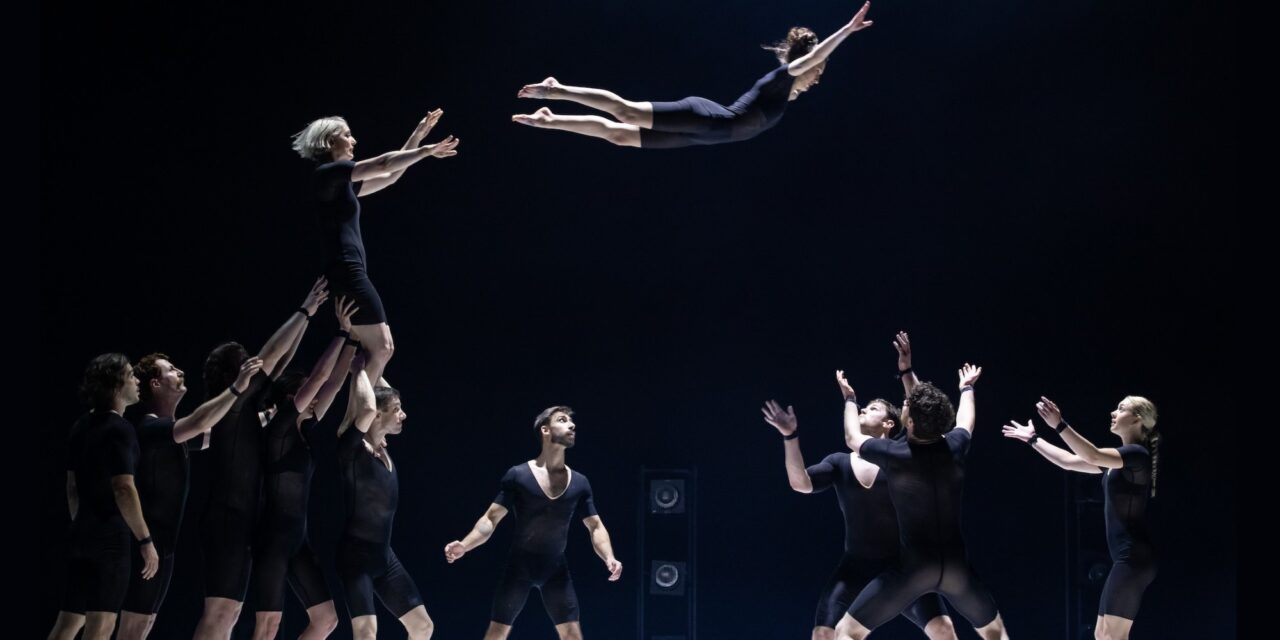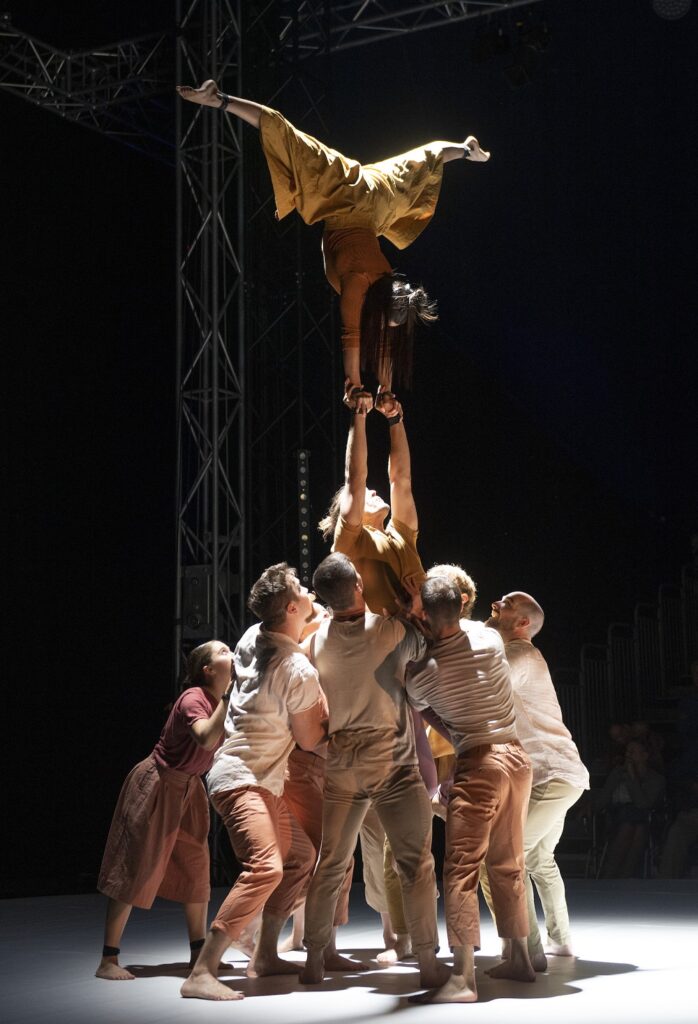Performers roll on their backs, lifting their limbs like babies studying gravity. They grasp at the air, clawing, until they can turn over. Slowly, they get to their knees. This introductory image encapsulates Circa’s mission to control and challenge the body’s capabilities in “Humans 2.0,” evolving from the individual to the ensemble.
Appearing at the Wallis Annenberg Center for Performing Arts, Circa Contemporary Circus, an Australia-based circus company under the direction of Yaron Lifschitz, first narratively explored the body’s physical limits with “Humans” which premiered in January 2017. “Humans 2.0,” which premiered in January 2021, expands upon their discoveries that challenge and experiment with human ability. As a unit, they refine the importance of physical and emotional connection in their search to reach new heights. In three acts, Circa accomplishes what it sought to discover.
Act one is about learning to connect. The performers slowly test the waters with connection as they stand atop each other’s shoulders for a brief moment before getting back to the ground. The energy shifts when Malte Gerhardt jumps up and backward with no one behind him. Quickly, Oscar Morris runs behind to catch him even though he is farther away from him on stage. It causes the heart to jump with fear, but that fright has no space on stage for the performers. Instead, it is humorous and smooth. Morris starts to contort Gerhardt into different positions while he remains stoic. Zachery Stephens even hops forward to tickle Gerhardt’s armpits. He does not budge. Although this contemporary circus addresses a sophisticated and serious exploration of human connection, moments like this remind us that the circus is about joy.
The limits are tested once again when Adam Storm starts walking on top of people’s backs and stomachs. The audience lets out a wince, but these performers know their bodies well enough to protect themselves as their weight sinks into them. Storm lands on Maya Davies. She rises in a backward bend as he stands on her abdomen. In unexpected pathways, they work together to rise until he stands on her shoulders. Here, the individual exploration of balance and control eases into group work.
Act two presents a new shock value centralized in the pelvis. Performers stand on the ground popping their hips left and right to the beat present in Ori Lichtik’s original music. It is all fun and games until a performer is flung across the stage and into a duo in a shoulder stand. As they land in the arms of the second person, altogether they absorb the shock of gravity and guide the person up to complete the three-person shoulder stand. The thrill of risky movement challenges the joyous energy, making you question whether to grit your teeth or smile.
The lighting design by Paul Jackson shines in act two with its strong musicality and connection to movement. There are poignant moments when the light shifts to match the next move. Kimberley Rossi runs forward and leaps with arms and legs spread wide. At the same time, four other performers catch her before she can land flat to the ground. As all five bodies touch, the warm lights lighting up the circular stage switch to a bright red. It is a mesmerizing transitional tool that Lifshitz and Jackson wield well.
Rossi stands out in the show, especially when she performs a straps routine, hanging from two looped straps. Her movement is dynamic, shifting from fast twists in the air to textured and sensual ones. Unlike other portions of “Humans 2.0,” this portion is artistic and tells a story of its own. It concludes with a final unwinding that leaves her hanging by the strength of her flexed foot with the tops of her feet looping over the strap alone.
The transition into act three is unlike the others. It is animalistic. Rossi and Jordan Hart crawl toward each other on the diagonal. Still dressed in pedestrian clothes designed by Libby McDonnell, the duo pulls their clothes off by their teeth to reveal an all-black set underneath. The action feels uneasy.
The Circa company swells together into a clump and takes a deep breath together. The mission to achieve communal connection reaches its final form. The group pulls a performer from the front to the back. Then another, this time by lifting their body by the head and slowly guiding her body backward. They are moving as one. The group explores unity even further when they balance off one body in groups of three or four, clinging to a single performer planted on the floor. The others contort their body to find balance over one person’s two feet. And in an astonishing moment, Davies climbs down from the top of a three-person shoulder stand with slow, controlled movement. After witnessing quick and nearly otherworldly acts, this slowed-down tempo lets us peek behind the curtain and the effort it takes to be in equilibrium with each other. The secret, as the crew had been trying to tell us all along, is the support of an ensemble.
A trapeze swings. The ensemble is in a circle, awaiting their turn to latch on. They take turns, following the progression of the swing. It feels like bodies colliding into one being — one breath.
“Humans 2.0” keeps going even though it gets its message across well by this point. Rossi swan dives down from a three-person-high shoulder stand, and the show ends abruptly. The show struggles to find the right punctuation. However, knowing that “Humans 2.0” is a continuation of “Humans,” there is bound to be another installation with answers to its run-on sentence.
For more information about Circa Contemporary Circus, please visit their website.
To learn more about The Wallis, please visit their website.
Written by Steven Vargas for LA Dance Chronicle.
Featured image: Circa “Humans 2.0” – Photo by David Kelly.










